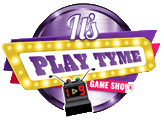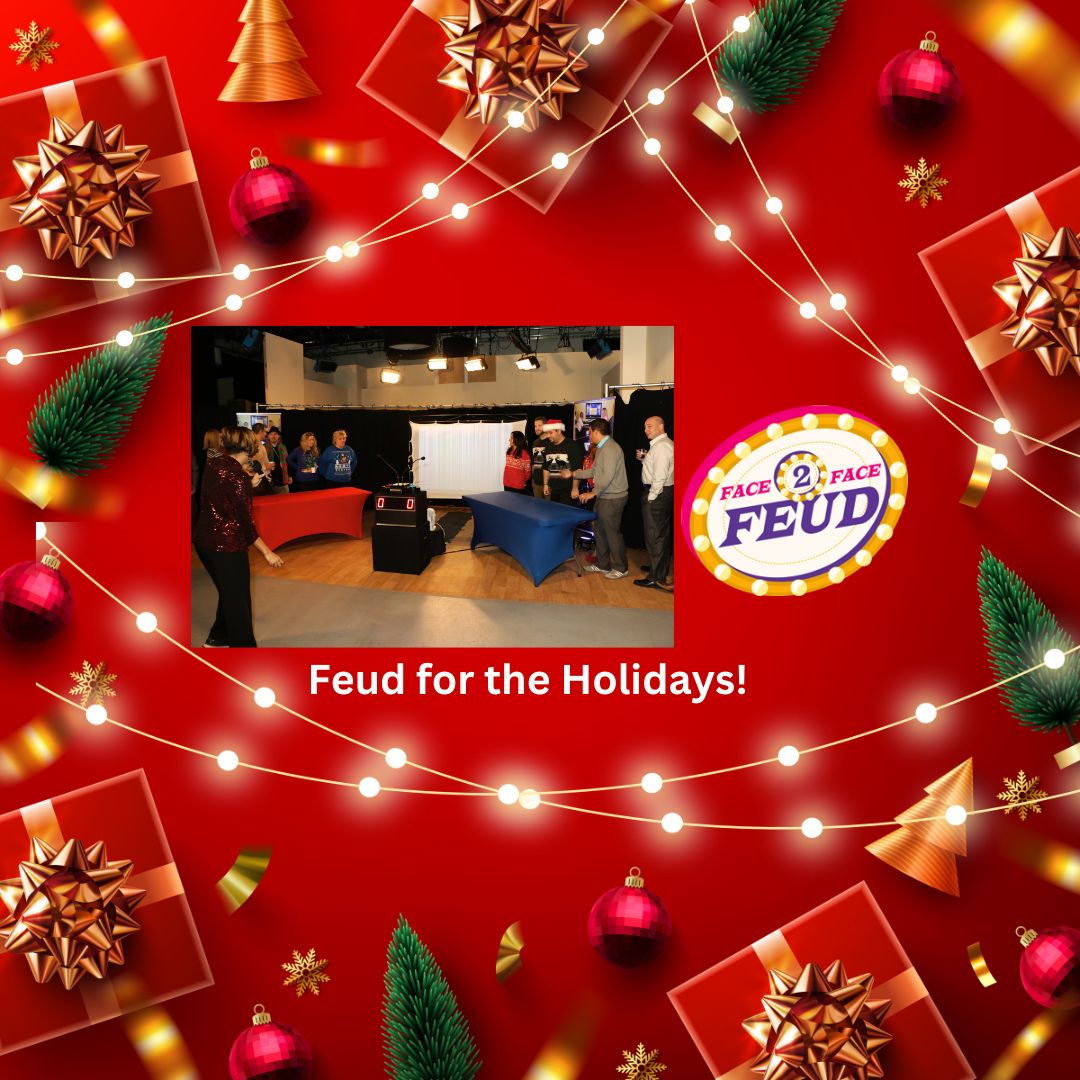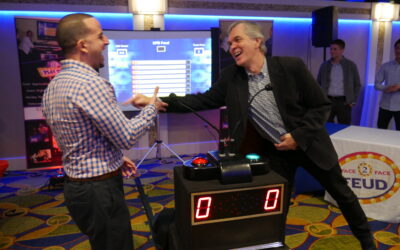Face-2-Face Feud for Corporate Holiday Parties
Hey there, holiday party planner extraordinaire! Are you scratching your head, wondering how to make this year’s corporate shindig the stuff of legend?
I get it, the pressure’s on to outdo last year’s office extravaganza. But before you dive headfirst into a sea of generic activities or passive entertainment options, let us introduce you to the game-changer: Face-2-Face Feud for Corporate Holiday Parties!
Trust us, this isn’t your run-of-the-mill holiday humdrum. Face-2-Face Feud is the glittering jewel in the crown of interactive holiday party experiences.
It’s like taking all the fun elements of your favorite game shows, mixing in some friendly rivalry, and serving it up with a side of belly laughs.
It’s the kind of entertainment that’ll have your colleagues talking about your party years later.
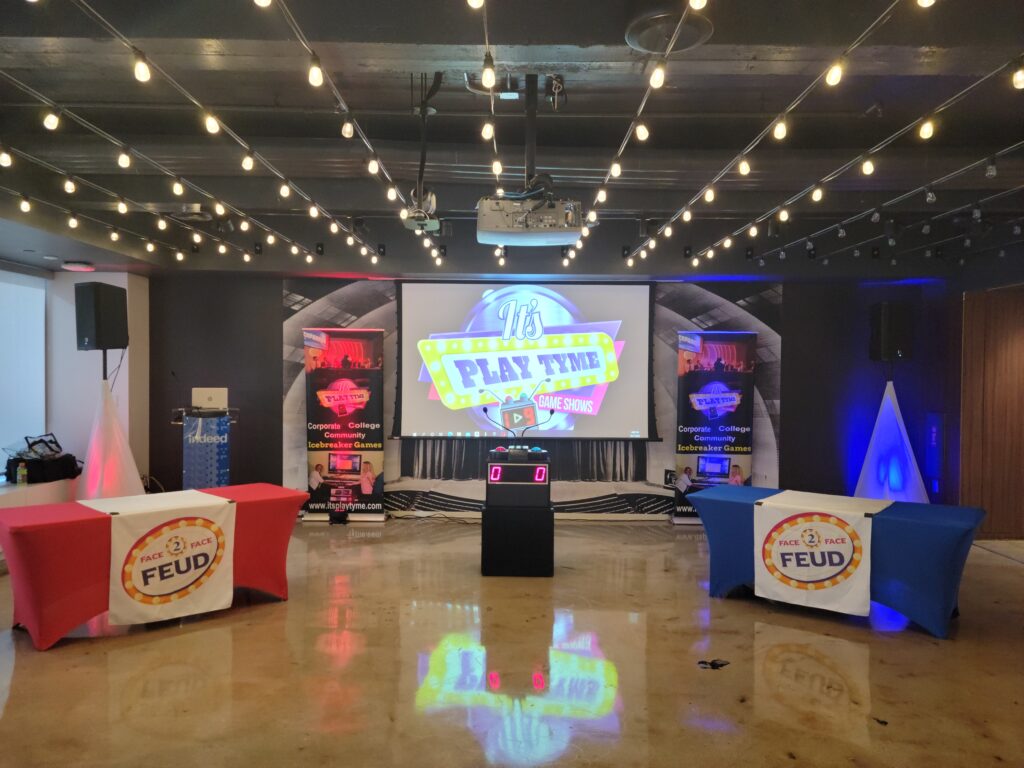
Game Show Set
In this article, we’re going to dive deep into the world of Face-2-Face Feud, showing you why it’s the only choice you should consider for your corporate holiday bash.
So, grab a cup of cocoa, get cozy, and let’s explore why Face-2-Face Feud is the game-changer you’ve been searching for to elevate your holiday party to epic proportions!
The Importance of adding “Fun Games” at Corporate Holiday Parties
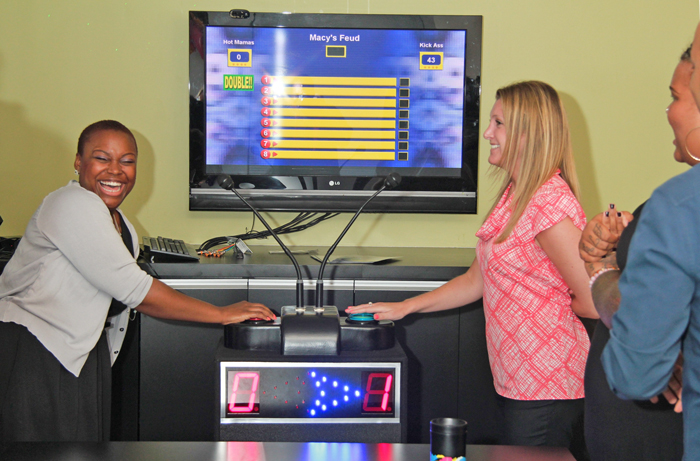
face-2-face_feud_nj
The significance of incorporating enjoyment at corporate holiday parties cannot be overstated.
A lively and engaging atmosphere can definitely bring employee morale, boost team dynamics, and create long lasting memories.
Adding activities such as the hilarious Family Feud style game called Face-2-Face Feud can enhance interaction and facilitate a sense of camaraderie among colleagues.
By promoting a fun-filled holiday gathering, employers can cultivate a positive work environment and strengthen employee relationships, leading to increased productivity and satisfaction.
Parties that prioritize amusement allow individuals to relax and unwind, fostering a sense of unity and connection within the company. Such initiatives contribute to a more cohesive and motivated workforce, ultimately benefiting the organization as a whole.
It is evident that hosting a festive event that prioritizes fun is a valuable investment in employee well-being and overall company success.
Key Takeaways:
- Bringing fun activities to corporate holiday parties is important to create a memorable and enjoyable experience for employees.
- Face-2-Face Feud is a great game for corporate holiday parties as it encourages teamwork, friendly competition, and laughter.
- To play feud, prepare questions and answers related to work-related topics, create a game board, divide the group into teams, decide the order of play.
- Challenge teams to guess the top-ranking answers, and consider ending the game with a fast paced trivia round for added excitement.
How to Play: Face-2-Face Feud
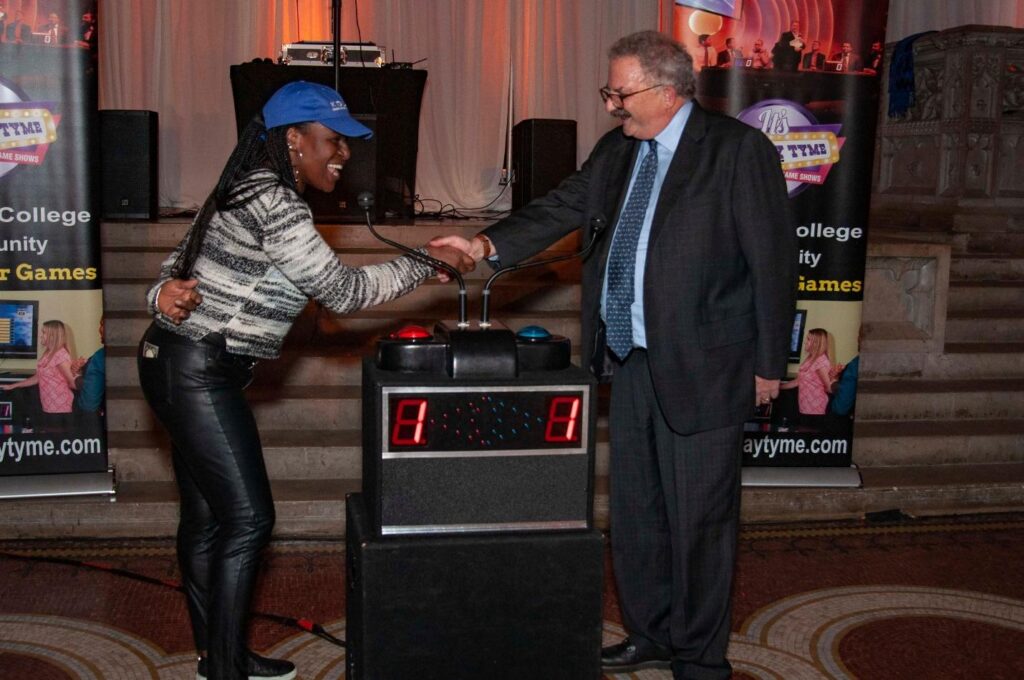
As we dive into the section on “How to Play Face-2-Face Feud,” get ready to bring the ultimate fun to your corporate holiday party!
We’ll start by preparing engaging questions and answers that will keep everyone on their toes.
Next, we’ll explore the process of making a game board that not only looks professional but also adds to the excitement.
Then, we’ll discuss the best way to split the group into teams, ensuring fair competition.
To keep things lively, we’ll reveal how to decide who goes first each round. And of course, we’ll unveil the thrilling challenge of guessing the top-ranking answers.
Finally, we’ll introduce an optional twist to end the game with a thrilling round of Game Show Mania Trivia.
So, let’s dive into the details and make your corporate holiday party an unforgettable success!
Preparing the Questions and Answers
- When preparing the questions and answers for your corporate holiday party, there are a few key steps to follow. First, brainstorm a list of relevant and engaging questions that will be entertaining for the participants. Second, create a corresponding list of answers that can be ranked based on popularity. Finally, organize the questions and answers into a game board or format that will be easy for teams to view and interact with during the game.
- To prepare the questions and answers for your corporate holiday party:
- Brainstorm a list of engaging and relevant questions that will captivate participants.
- Create a corresponding list of answers that can be ranked based on popularity.
- Organize the questions and answers into a game board or format that is easily accessible for teams during the game.
It is important to note that when creating the questions, it is best to focus on topics related to work or office life to keep the game relevant to your colleagues’ experiences.
By utilizing this methodical approach in preparing the questions and answers, you can ensure an entertaining and engaging activity for everyone involved.
A true fact related to this topic is that playing games at corporate holiday parties can improve team spirit and create a more positive work environment
Making a game board is like a corporate version of arts and crafts, except instead of popsicle sticks and glue, you use your coworkers’ hopes and dreams.
Making a Game Board
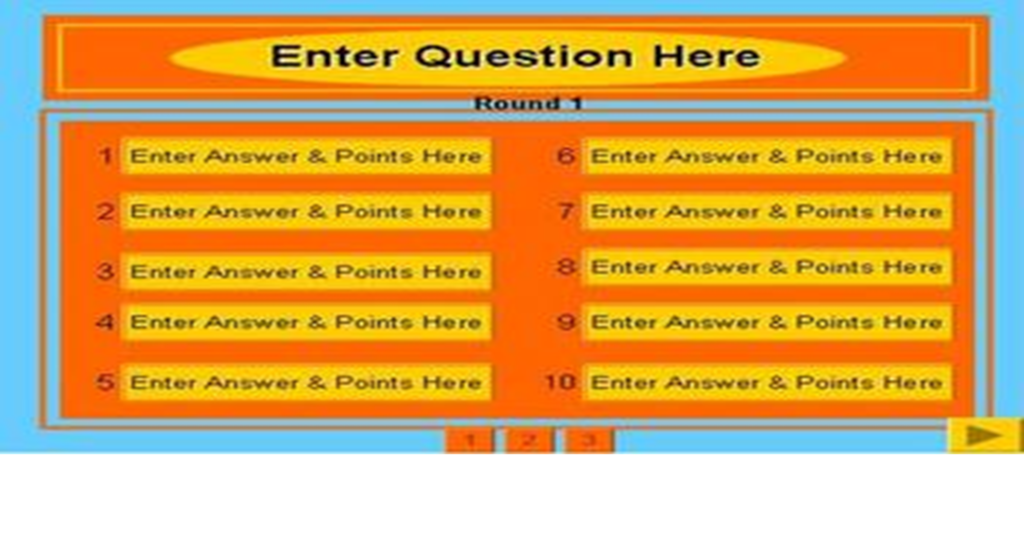
To make a game board, here are the following three simple steps:
1. Prepare the materials: Start by gathering a large poster board or whiteboard and markers in different colors. Use the markers to draw a grid on the board, with columns and rows for questions and answers.
2. Add categories and points: Write down the categories of questions you have prepared for the game, such as “Reasons You Might Be Late to Work” or “Perks of Working from Home.” Assign different point values to each category, ranging from 100 to 500 or more.
3. Fill in the questions and answers: Write down the specific questions and their corresponding top-ranking answers within each category. Make sure to use clear and concise language that is easy for participants to understand.
Remember to be creative with your design and presentation of the game board, adding visual elements that align with your corporate holiday party theme.
Splitting the Group into Teams
Splitting the group into teams is a crucial step in organizing corporate holiday parties. It ensures that everyone gets involved and promotes teamwork and friendly competition.
Here’s a 6-step guide to effectively splitting the group into teams:
1. Determine Team Size: Decide on the ideal team size based on the number of participants and the activities planned for the event.
2. Random Selection: Randomly assign participants to teams to ensure fairness and prevent any bias or favoritism.
3. Consider Diversity: Take into account the mix of skills, personalities, and departments when forming teams to encourage collaboration and create a balanced playing field.
4. Team Names: Allow each team to choose a unique name representing their identity and fostering camaraderie among teammates.
5. Create Team Spirit: Encourage teams to come up with chants, slogans, or team symbols to boost morale and create a sense of unity.
6. Provide Instructions: Clearly communicate the rules, objectives, and expectations for each team to ensure smooth execution of activities throughout the event.
Optimally splitting the group into teams promotes engagement, enhances social interaction, and contributes to an enjoyable corporate holiday party experience.
Deciding who goes first each round is like determining who gets the last piece of cake at a party, it requires strategy, diplomacy, and a healthy dose of bribery.
Deciding Who Goes First Each Round
To determine the order in which teams will play each round, you can follow these steps:
- 1. Assign a number or color to each team: Give each team a unique identifier, such as a number or color, to easily distinguish them.
- 2. Use a random selection method: To ensure fairness, use a random selection method like drawing names from a hat or using a random number generator.
- 3. Rotate the order: If you have multiple rounds, rotate the order in which teams go first so that no team consistently has an advantage or disadvantage.
- 4. Consider the scoring system: If you have a scoring system where teams earn points based on their performance in each round, you may want to alternate the starting team to ensure equal opportunities for all.
- 5. Communicate the order: Clearly communicate the determined playing order to all participants before each round begins.
- 6. Update and adjust if necessary: Be open to adjusting the order if unforeseen circumstances arise or if teams request changes during the game.
These steps will help you decide who goes first in each round of your corporate holiday party game, ensuring fairness and excitement for all participants.
When determining which team gets to start each round, it is important to consider factors such as fairness and equal opportunities for all teams involved.
By following these steps, you can establish an unbiased process that adds an element of suspense and excitement to your game.
In previous iterations of corporate holiday parties, deciding who goes first each round was often determined by simple methods such as flipping a coin or picking numbers out of a hat.
However, as games became more sophisticated and complex over time, new methods were introduced to add fairness and balance to play sequences.
Challenging Teams to Guess the Most Popular Answers
1. Splitting the group into teams allows for a dynamic competition atmosphere.
2. Deciding who goes first each round adds anticipation and strategy to the game.
3. Presenting the most popular answers challenges teams to think critically and predict popular responses.
4. Adding an optional Fast Money round or trivia battle intensifies the challenge, as teams race against the clock to guess the right answers.
Adding these elements not only enhances the excitement of the game but also encourages teamwork, communication, and friendly competition.
To make Challenging Teams to Guess the Top-Ranking Answers even more captivating, consider adding a twist such as introducing bonus rounds or offering prizes for correctly guessing all top-ranking answers in a category.
Ending the Game with Trivia – Optional
To add excitement and increase competition, there is an option to conclude the game with a round of Game Show Mania Trivia.
This segment allows teams to earn bonus points by answering questions under a time limit, making it an exhilarating way to end the game.
A 3-Step Guide to Trivia:
1. Selecting Participants: Choose one member from each team to participate in the fast money bonus round. These participants should be quick thinkers and have good communication skills.
2. Time Limit and Questions: Set a time limit, typically one minute, for each participant to answer five questions. The questions can be related to general knowledge or specific topics discussed during the game.
3. Points Allocation: Allocate points based on the number of people surveyed who provided the same answer as the participant. Each matching answer earns points, and at the end of the round, tally up all points earned by both participants.
Additional Tips for Trivia Round:
To enhance engagement and excitement, consider incorporating unique aspects like using led buzzers or visual aids for answering questions.
Trivia Round Story:
During a company’s holiday party, the trivia bonus round added an unexpected twist when two team members became tied in their final scores.
The intensity rose as they faced off in a sudden-death question, leaving everyone on edge. In a nail-biting finish, one participant emerged victorious, making it a memorable conclusion to the game-filled evening.
Face-2-Face Feud Questions and Answers
Ever wondered how to bring some excitement to your upcoming corporate holiday party?
We’ll explore a variety of topics, such as reasons for being late to work, perks and downsides of working from home, common email faux pas, and even fictional bosses we would hate to work for.
Get ready to discover the hilarious, surprising, and relatable responses that will make your corporate holiday party a memorable one!
FF Question: Name a Reason You Might Be Late to Work?
One Possible Explanation:
In a corporate setting, employees may encounter various reasons for being late to work, impacting their productivity and punctuality.
These reasons can range from unforeseen circumstances to personal challenges. Understanding the factors that contribute to lateness is essential for employers to develop supportive policies and create a productive work environment.
- Unforeseen Events: Unexpected situations such as traffic congestion or public transportation delays can cause employees to be late for work.
- Personal Obligations: Responsibilities like dropping off children at school, attending medical appointments, or dealing with personal emergencies can result in tardiness.
- Health Issues: Illnesses or medical conditions that require additional time for treatment or recovery may lead to delays in arriving at the workplace.
- Technology Failures: Technical glitches, computer malfunctions, or network connectivity issues can hinder an employee’s ability to start working on time.
Understanding the unique challenges individuals face when it comes to punctuality allows organizations to provide necessary support and flexibility.
FF Question: Name the Perks of Working from Home?
Working remotely: List the advantages of working from home, outlining the benefits associated with this arrangement.
- Flexibility: Employees have the freedom to create a schedule that suits their individual needs, allowing for better work-life balance.
- Eliminating commute: By avoiding daily commutes, employees save time and reduce stress levels, leading to increased productivity.
- Cost-saving: Working from home eliminates expenses related to commuting, such as fuel costs or public transportation fees, resulting in financial savings.
- Comfortable environment: Employees have the opportunity to customize their workspace based on their preferences, promoting comfort and potentially enhancing focus and creativity.
- Increased autonomy: Working remotely allows individuals to take ownership of their tasks and work independently, fostering a sense of autonomy and self-motivation.
Furthermore, remote work provides ample opportunities for professional growth through improved time management skills and the ability to seamlessly collaborate with colleagues online.
To make remote work more effective:
- Set clear expectations about goals, deadlines, and deliverables.
- Establish regular communication channels to maintain open lines of collaboration.
- Encourage breaks throughout the day to prevent burnout and promote overall well-being.
- Provide technology resources, such as video conferencing tools or project management platforms, to facilitate smooth remote operations.
By embracing these perks and implementing effective strategies, organizations can enhance employee satisfaction and productivity while nurturing a positive remote work culture.
FF Question: Name Downsides to Working from Home?
Working remotely has its fair share of challenges. Here, we will explore the downsides of working from home and shed light on some important considerations.
Distractions: One downside to working from home is the potential for distractions. With the comforts and conveniences of home, it can be difficult to maintain focus and productivity.
Lack of Separation: Another downside is the blur between work and personal life. Without a physical separation between the two, it can be challenging to establish boundaries and maintain a healthy work-life balance.
Limited Social Interaction: Lastly, remote work can lead to a sense of isolation. Without regular face-to-face interactions with colleagues, there may be a decrease in social engagement and opportunities for collaboration.
It’s important to acknowledge these downsides when transitioning to remote work or considering it as an option for your organization.
However, with proper planning and communication strategies in place, these challenges can be mitigated.
Pro Tip: Create a dedicated workspace within your home that signals to your brain that it’s time to focus on work.
FF Question: Name Something You Would Be Angry at a Coworker for Stealing?
In the workplace, it can be infuriating when a colleague takes something that doesn’t belong to them.
This behavior not only violates trust but also disrupts the smooth functioning of the office environment.
Here are four instances of things that you would surely be angry at a coworker for stealing:
- Office Supplies: From pens and staplers to notebooks and sticky notes, office supplies are essential for productivity. Discovering that a coworker has helped themselves to your supplies can be frustrating and hinder your ability to work efficiently.
- Food from the Fridge: Many workplaces have communal refrigerators where employees store their lunches or snacks. If someone decides to help themselves to your carefully packed lunch or tasty snack, it is not only a breach of trust but also an invasion of personal space.
- Ideas or Credit: Collaboration and teamwork are vital in any workplace, but it becomes problematic when a coworker steals credit for your ideas or passes them off as their own. It can be demoralizing and create a toxic atmosphere within the team.
- Personal Belongings: Whether it’s a favorite coffee mug, headphones, or other personal items, having these things disappear from your desk due to a thieving colleague can lead to both frustration and distrust.
It is crucial to foster an environment of respect and professionalism in the workplace.
Theft, even on a small scale, can erode this culture and negatively impact team dynamics.
By addressing these issues openly and enforcing clear guidelines regarding personal boundaries and respect for others’ possessions, such incidents can be minimized.
Pro Tip: Encouraging open communication between colleagues regarding shared spaces and belongings can help prevent misunderstandings and reduce potential conflicts.
FF Question: Name an Email Faux Pas?
An Email Faux Pas refers to a mistake or an inappropriate behavior made when sending or responding to emails.
It is important to be mindful of these mistakes in order to maintain professional communication and avoid misunderstandings.
Not using proper email etiquette: This includes not using a polite greeting or closing, not addressing the recipient correctly, or using excessive capitalization or exclamation points.
Sending emails with typos or grammatical errors: This can give a negative impression and undermine your professionalism.
Forgetting to double-check the recipients before sending: Sending an email to the wrong person can lead to confidential information being shared with unintended recipients and can cause serious consequences.
These are just a few examples of common Email Faux Pas. It is crucial to pay attention to details and communicate effectively through emails in order to maintain professional relationships in the workplace.
One incident that highlights the importance of avoiding Email Faux Pas involves a company executive accidentally sending an email complaining about an employee’s performance directly to that employee instead of their intended recipient.
This led to an uncomfortable situation and strained working relationship between the executive and the employee.
This serves as a reminder of how vital it is to exercise caution when composing and sending emails.
FF Question: Name a Food You Would Be Excited to Find in the Breakroom?
In an office breakroom, employees often find themselves excited to discover a delicious food item waiting for them.
The anticipation of a tasty treat can boost morale and provide a momentary escape from the workday grind.
Here are six types of foods that employees would eagerly look forward to finding in the breakroom:
Freshly baked pastries and muffins: A warm, buttery croissant or a freshly baked blueberry muffin can instantly brighten up someone’s day. –
Gourmet sandwiches and wraps: The variety of flavors and fillings in gourmet sandwiches and wraps offer a satisfying and convenient lunch option for busy professionals. –
Healthy salads with vibrant ingredients: Nourishing salads filled with fresh vegetables, protein, and flavorful dressings provide employees with a refreshing break from heavier meals. –
Indulgent desserts like chocolate cake or cheesecake: A delectable dessert brings joy to any occasion, making it a delightful surprise to stumble upon in the breakroom. –
Premium coffee or specialty tea: A well-equipped breakroom with high-quality teas and coffees allows employees to enjoy their favorite hot beverages without having to leave the office. –
Artisanal snacks such as gourmet popcorn or exotic fruit trays: Unique treats like these add excitement to snack time while offering options beyond the ordinary. Beyond these points, it is essential for employers to consider catering to dietary preferences and restrictions when stocking the breakroom.
Providing vegetarian, vegan, gluten-free, or dairy-free options ensures that every employee can partake in the excitement of finding something enjoyable in the breakroom.
To create even more enthusiasm around discovering food items in the breakroom, employers could implement a rotating menu of diverse cuisines or encourage employees to share their own recipes for communal enjoyment.
Hosting occasional themed potlucks or tastings can foster a sense of camaraderie among coworkers while expanding culinary horizons.
By continuously offering new and exciting food experiences in the breakroom, employers can cultivate a positive and enjoyable workplace environment.
FF Question: Name an Occasion When You Might Buy a Coworker a Present
When to Buy a Gift for a Colleague
It’s important to acknowledge and celebrate special occasions in the workplace by giving gifts to colleagues. Here are some occasions when you might consider buying a present for a coworker:
- Work Anniversary: Commemorating years of service with the company is a great opportunity to show appreciation.
- Birthday: Acknowledging birthdays creates a sense of camaraderie and boosts morale in the office.
- Promotion: Celebrating promotions not only recognizes achievements, but also motivates others to strive for success.
- Retirement: Saying goodbye and honoring a coworker’s retirement with a thoughtful gift helps foster a positive work environment.
- Thank You: Expressing gratitude for assistance, support, or collaboration is an occasion that warrants giving a present.
These instances provide opportunities to strengthen relationships and create a positive work culture. Celebrate your coworkers’ milestones by showing thoughtfulness and fostering goodwill within the organization.
Pro Tip: When selecting gifts, consider personal preferences, hobbies, or interests of the recipient for a more meaningful gesture.
FF Question: Name Something You Could Not Get Through the Workday Without?
In a professional setting, it is essential to identify the key elements that are indispensable in maintaining productivity throughout the workday. These critical components play a significant role in ensuring a smooth workflow and maximizing efficiency. Let’s explore the various factors that contribute to a successful workday.
- A Reliable Task Management System: A reliable task management system is crucial for staying organized and prioritizing tasks effectively. It helps in planning and tracking progress, ensuring no important assignments slip through the cracks.
- Efficient Communication Tools: Seamless communication is vital for successful collaboration within a team. Utilizing efficient communication tools enables effective information sharing, quick decision-making, and timely feedback exchange.
- Access to Relevant Information/Resources: Having access to relevant information and resources is essential for performing tasks efficiently. Whether it’s research materials or data analysis tools, having easy access contributes to better problem-solving and decision-making abilities.
- Supportive Colleagues: Working in an environment with supportive colleagues fosters a positive work atmosphere. Supportive colleagues provide necessary assistance, guidance, and inspiration, resulting in enhanced productivity and job satisfaction.
- Regular Breaks: Taking regular breaks throughout the workday is crucial for avoiding burnout and maintaining mental wellbeing. Short breaks help recharge energy levels, improve focus, and prevent monotony.
- Self-care Practices: Prioritizing self-care practices such as exercise, mindfulness techniques, or healthy eating habits contributes to maintaining overall well-being during the workday.
In addition to these factors, remember to acknowledge your personal needs when considering what you cannot get through the workday without. Each individual may have unique preferences or requirements that contribute to their optimal performance at work.
FF Question: Name a Fictional Boss You Would Hate to Work For?
Working under a fictional boss who displays undesirable qualities can hinder job satisfaction and productivity.
A manager’s inability to communicate effectively, lack of empathy, or unreasonable demands can create a toxic work environment.
Collaborating with a boss who exhibits these traits can adversely affect employee morale and motivation.
Dealing with a fictional boss who constantly micromanages every task would undoubtedly be demoralizing.
Their obsession with controlling every aspect of the work process not only stifles creativity but also undermines employees’ confidence in their abilities.
Such rigid supervision could breed resentment among team members and limit their growth potential.
Furthermore, working for a fictional boss who lacks clear vision or strategic direction would be frustrating.
This type of leader often fails to provide guidance or set realistic goals, leading to confusion and chaos within the organization.
Without proper direction, employees may experience uncertainty in their roles and responsibilities, making it difficult for them to perform at their best.
Additionally, having a fictional boss with an abusive management style can be highly detrimental to workplace well-being. Constant berating, belittling, or undermining employees’ efforts not only harms their self-esteem but also creates an atmosphere of fear and hostility. Under such conditions, teamwork and collaboration become nearly impossible, impeding progress and hindering overall success.
To address these challenges, organizations must promote effective leadership training programs that emphasize communication skills, empathy, and the ability to inspire trust among employees. Encouraging open dialogue through regular team meetings or individual check-ins can help prevent misunderstandings and establish a positive work environment.
Moreover, fostering a culture of respect and recognition will go a long way in motivating employees to excel in their roles. Recognizing exceptional performance through rewards or acknowledgments boosts engagement levels while encouraging healthy competition among coworkers.
FF Question: Name a Food That Would Be Hard to Eat at Your Desk?
In a professional setting, it can be challenging to eat certain foods at your desk. Here are some examples of foods that would be difficult to consume while working:
- Soups or stews: Eating soups or stews can be messy and may require the use of both hands, making it inconvenient to eat at a desk.
- Spaghetti or noodles: Twirling spaghetti or noodles with a fork can be tricky, resulting in potential food spills and stains on work documents.
- Tacos or burritos: These handheld foods often have fillings that can easily fall out and create a mess on your desk. –
- Sticky desserts: Treats like sticky toffee pudding or caramel-covered apples can leave residue on your hands and make using a keyboard or mouse challenging.
It is important to consider these factors when choosing what foods to enjoy at your workspace, as it can impact productivity and cleanliness.
FF Question: Name a Reason You Might Be Nervous at Work?
In a professional setting, there are several factors that may cause individuals to feel anxious or unsettled while at work. Understanding the reasons behind this nervousness can help employers and colleagues create a supportive and productive work environment. Here are four common reasons why someone might experience nervousness at work:
- Performance Reviews: Anticipating feedback during performance evaluations can create anxiety for employees, as they strive to meet expectations and achieve success in their roles.
- Presentation or Public Speaking: Delivering presentations or speaking in front of colleagues can be nerve-wracking for many individuals, as they may fear judgment or criticism.
- Workplace Conflicts: Dealing with conflicts or disagreements with coworkers or superiors can lead to feelings of unease, especially if the resolution is uncertain.
- New Challenges: Starting a new project, taking on additional responsibilities, or entering unfamiliar territory within one’s role can cause nervousness as individuals navigate through transitions and unknowns.
While these are some common reasons individuals may experience nervousness at work, it is important to note that each person’s experience may vary based on their unique circumstances. By fostering open communication and providing support, organizations can empower employees to manage and overcome workplace anxiety.
FF Question: Name Someone Besides Your Coworkers or Clients Who Might Call You at Work?
In a professional setting, it is important to be aware of individuals who may call you at work besides your coworkers or clients. This includes people who have a direct connection to your work but might not fall into the traditional categories.
Here are three points to consider:
- Name Someone Besides Your Coworkers or Clients Who Might Call You at Work:
- Superiors: Managers, supervisors, or executives who may need to discuss work-related matters with you.
- Support Staff: Receptionists, IT personnel, or administrative assistants who may reach out for various reasons.
- Vendors or Suppliers: Individuals from external organizations who collaborate with your company and may contact you regarding procurement or other business matters.
It is essential to note that these individuals play a significant role in the work environment. Understanding their potential involvement and effectively communicating with them contributes to overall productivity and efficiency.
In addition to coworkers and clients, professionals like superiors, support staff, and vendors often connect in workplace settings.
Fun Fact: According to an article titled “The Importance of Fun in Corporate Holiday Parties,” incorporating games like Coworker Feud can enhance enjoyment and foster team building during such events.
FF Question: Name a Superhero Who Might Make a Bad Coworker?
In today’s fast-paced corporate world, teamwork and collaboration are crucial for success. When it comes to naming a superhero who might make a bad coworker, it’s important to consider characteristics that may hinder effective collaboration and disrupt the harmony within the team. Here are five superheroes who, despite their incredible abilities, may not be ideal in a coworking environment:
1. The Hulk: While the Hulk possesses immense strength and power, his unpredictable temper could easily lead to conflicts with coworkers. His lack of control over his emotions might make him prone to outbursts and potentially damage work relationships.
2. Deadpool: Known for his sarcastic wit and reckless behavior, Deadpool’s irreverent nature may not be well-suited for a professional setting. His tendency to break rules and disregard authority could create disruptions and hinder team cohesion.
3. Mystique: As a shapeshifter capable of impersonating others, Mystique’s ability to deceive might undermine trust among coworkers. Her constant changing of appearances can lead to confusion and misunderstandings within a team.
4. Doctor Strange: While his mastery of magic and sorcery makes Doctor Strange an impressive superhero, his preoccupation with otherworldly matters might distract him from focusing on work tasks or collaborating effectively with colleagues.
5. Rocket Raccoon: Although Rocket Raccoon is incredibly intelligent and resourceful, his abrasive personality and tendency to act impulsively could be disruptive in a professional setting. His sarcastic remarks and propensity for mischief may strain working relationships.
While these superheroes have unique abilities that can undoubtedly benefit society in different ways, their traits may not align well with the dynamics of a typical workplace environment. It is important to consider factors such as communication skills, temperament, adaptability, and professionalism when evaluating whether a superhero would make a good coworker.
When creating teams or assigning roles at work, it is essential to assess these characteristics beyond just superpowers or abilities. By selecting coworkers who possess qualities like effective communication, teamwork, and a positive attitude, organizations can foster a more harmonious and productive work environment.
To ensure successful collaboration, it is also crucial to establish clear expectations and guidelines for behavior in the workplace. Encouraging open communication, empathy, and mutual respect among team members can help mitigate conflicts that may arise due to diverse personalities and working styles.
FF Question: Name an Item You Might Forget at Work That Would Cause Problems?
In the workplace, it is not uncommon to forget important items that can cause problems. Forgetting essential items can disrupt productivity and create unnecessary challenges. Here are six items that individuals might forget at work, leading to potential issues:
- Access badge: Forgetting your access badge can prevent you from entering the building or specific areas, causing delays and inconvenience.
- Cell phone: Without your cell phone, you may miss important calls, messages, or emails, hindering communication and potentially affecting your work responsibilities.
- Work laptop or documents: Leaving behind your work laptop or essential documents can hinder progress on projects and restrict access to necessary information.
- Lunch or snacks: Without proper sustenance, not having lunch or snacks during the workday can result in decreased energy levels and difficulties focusing on tasks.
- Charger or power bank: Failing to bring a charger or power bank for your electronic devices may result in drained batteries and limited functionality throughout the day.
- Important deadlines or appointments: Forgetting about critical deadlines or appointments can lead to missed opportunities and negatively impact work relationships.
Remembering these essential items will help ensure a smooth and productive workday without any unnecessary complications.
It is important to note that in addition to these six items mentioned above, other forgotten belongings such as personal medication, headphones, office keys, or necessary equipment like a mouse, keyboard, or pen drive can also cause inconveniences at work. Being aware of all necessary items before leaving for work can help avoid any potential issues during the day.
On an interesting note, there have been instances where employees forgot their laptops at home before crucial presentations.
This resulted in last-minute scrambling for alternative arrangements and added stress for both the employee and the team involved.
Therefore, it serves as a reminder for individuals to carefully pack their bags with all essential items needed for a successful day at work.
FF Question: Name Something You Might Say During a Zoom Meeting?
During a Zoom meeting, you may find yourself saying phrases like “Can everyone hear me?“, “Please mute your microphone“, or “Let’s move on to the next agenda item“.
It is important to communicate effectively and stay engaged during virtual meetings to ensure smooth collaboration and productivity.
Remember to use clear and concise language, maintain professional etiquette, and actively participate in discussions.
In addition to these common phrases, it is also helpful to use other statements such as “I have a question/comment“, “Could you please share your screen?“, or “Let’s schedule a follow-up meeting“.
These words can facilitate effective communication and interaction among participants.
It is crucial to adapt your communication style to the virtual setting and be mindful of potential technical issues that may arise.
Maintaining a respectful tone and listening attentively to others’ contributions promotes a positive virtual meeting environment.
Always address colleagues by their names when speaking, provide constructive feedback when necessary, and express appreciation for their input.
Also, consider using non-verbal cues such as nodding or thumbs-up gestures to engage with others visually.
Enhance your virtual communication skills by practicing delivering impactful messages.
Be clear, concise, and engaged. Develop strategies for effective online collaboration that will lead to more productive meetings and stronger connections with your remote team members.
Conclusion
Face-2-Face Feud game turns your corporate holiday party into an exciting and enjoyable experience.
By incorporating this interactive activity, you can bring a fun and engaging element to your event.
The game fosters team building, encourages friendly competition, and provides entertainment for everyone involved. Infusing your corporate holiday party with Face-2-Face Feud ensures a memorable and enjoyable experience for all attendees.
Furthermore, this game promotes interaction among colleagues, fostering a sense of unity and camaraderie within the organization.
It breaks the ice and encourages open communication, leading to stronger relationships and a more positive work environment.
The game allows customization, making it adaptable to your company’s specific holiday party theme or branding.
This flexibility ensures a seamless integration of the game into your event, creating a personalized and memorable experience for your employees.
With its popularity and success, Face-2-Face Feud game has been widely recognized as a top choice for corporate holiday parties.
FAQs
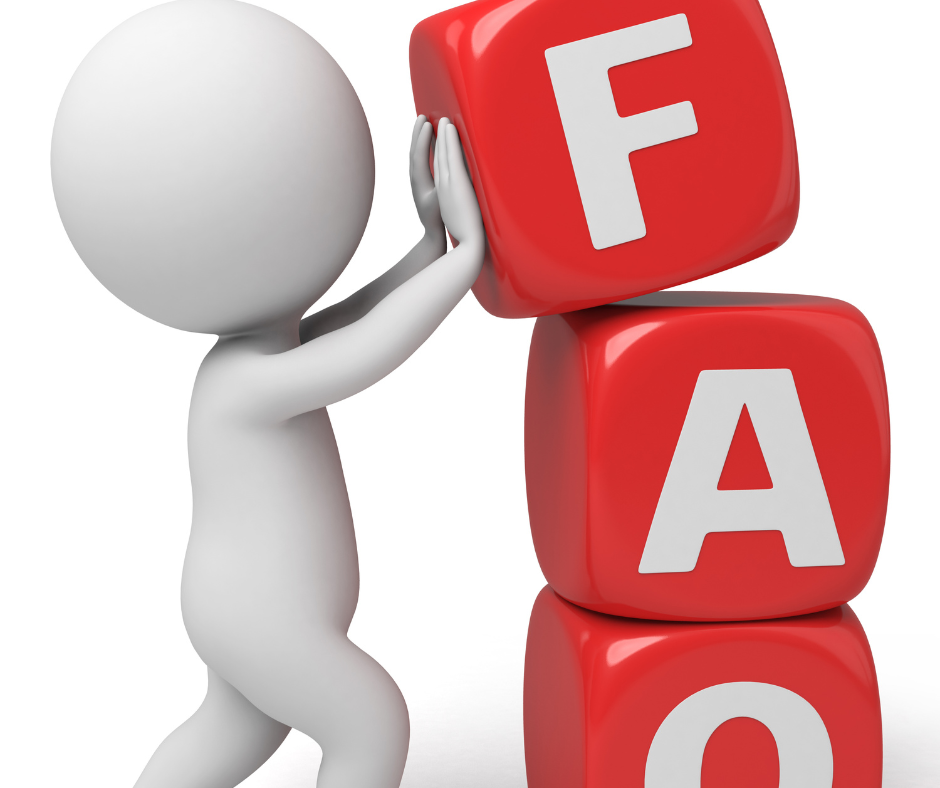
frequently asked questions
1. How can I bring the fun to my corporate holiday party?
To bring the fun to your corporate holiday party, consider hosting the Face-2-Face Feud Game!
This game show-inspired activity is a great way to boost camaraderie and encourage group decision making.
You can play the game virtually on platforms like Zoom, using a feud template or a digital whiteboard to display the game board.
2. How do I play?
Playing the Ultimate Family Feud Game is easy! Here are the instructions:
- Prepare a set of questions and answers related to your workplace. You can find pre-made questions online or create your own.
- Divide your group into teams. You can go with the classic department vs department approach or get creative with other team formations.
- Decide who will go first each round. This can be determined through a coin toss or by taking turns.
- Challenge teams to guess the top-ranking answers to each question. Each team takes turns guessing, and points are awarded based on the number of people who gave the same answer.
- Continue the game until all answers have been guessed or both teams have guessed incorrectly three times.
- If you want to add a thrilling element, consider ending the game with a lightning round called Fast Money, where two members of the winning team race against the clock to provide quick answers to five different questions.
3. Can I play the Face-2-Face Feud online?
Absolutely! You can easily play the Ultimate Family Feud Game online through platforms like Zoom. Use a digital whiteboard or screen sharing to display the game board and allow teams to participate remotely.
This interactive experience will bring the game show fun right to your virtual game night!
4. How can the game help improve teamwork?
Face-2-Face Feud is an excellent team building exercise. By playing this game, your employees will gain a better understanding of how their colleagues think and make decisions.
It promotes collaboration, communication, and encourages group problem-solving.
It’s a fun and engaging activity that can foster a stronger sense of teamwork among your employees.
5. Where can I find pre-made questions and answers online?
If you’re looking for pre-made questions and answers online for the feud style game, you can find them online.
There are websites that offer pre-loaded questions with points, or you can search for specific categories related to your workplace.
Alternatively, you can create your own set of questions to customize the game and make it more tailored to your organization.
6. Can you provide some examples of work questions?
Sure! Here are a few examples of work questions you can use for Face-2-Face Feud.
- Name a reason you might be late to work?
- Name the perks of working from home?
- Name something you would be angry at a coworker for stealing?
- Name an email faux pas?
- Name a food you would be excited to find in the breakroom?
- Name an occasion when you might buy a coworker a present?
Planning a Feud Style Team Builder?
![]()
Need some help? Book a live game show experience today!
Contact us for further details.
For Immediate assistance by text – 917-670-4689
No deposit required. We plan and facilitate all activities.
